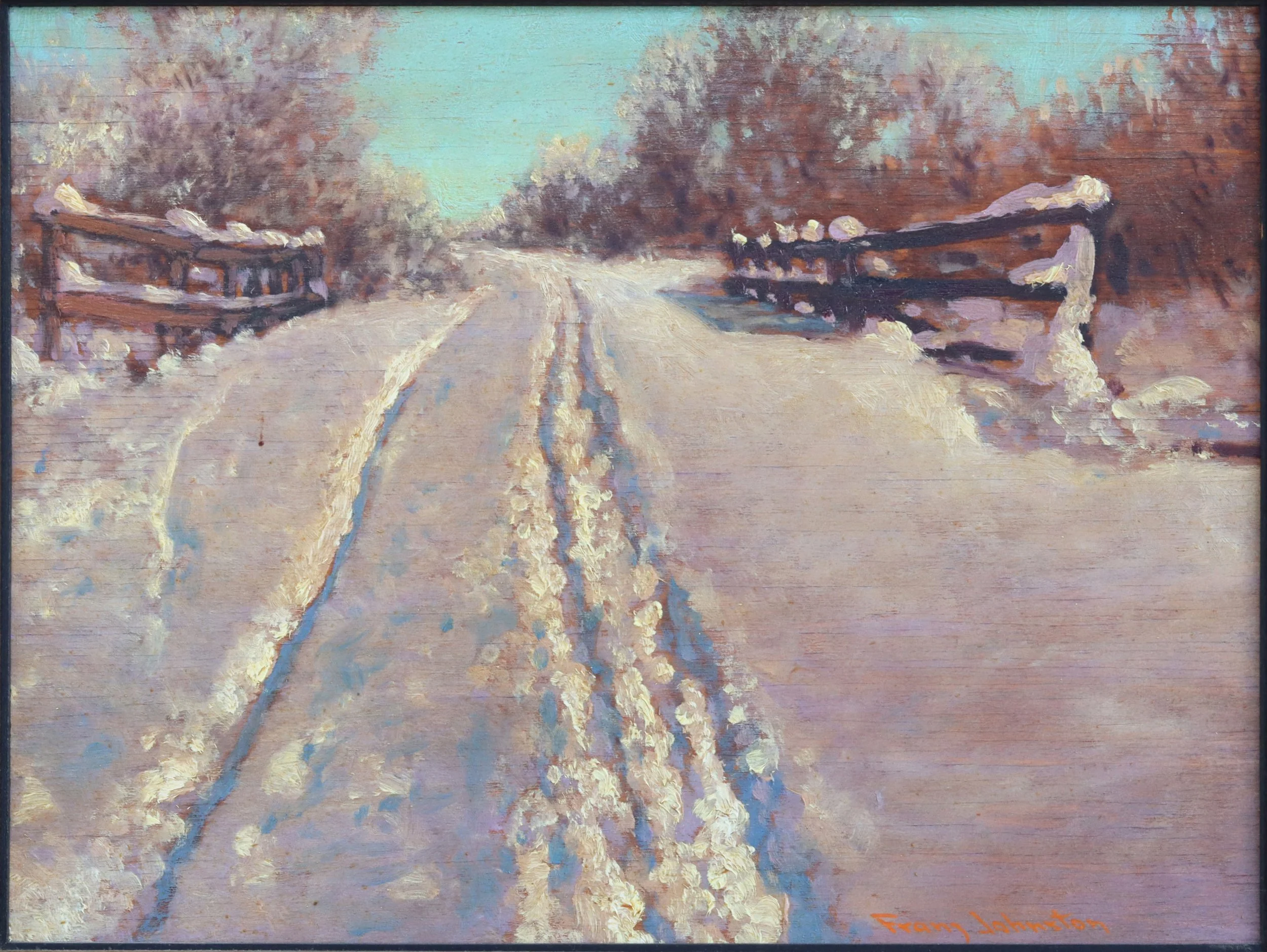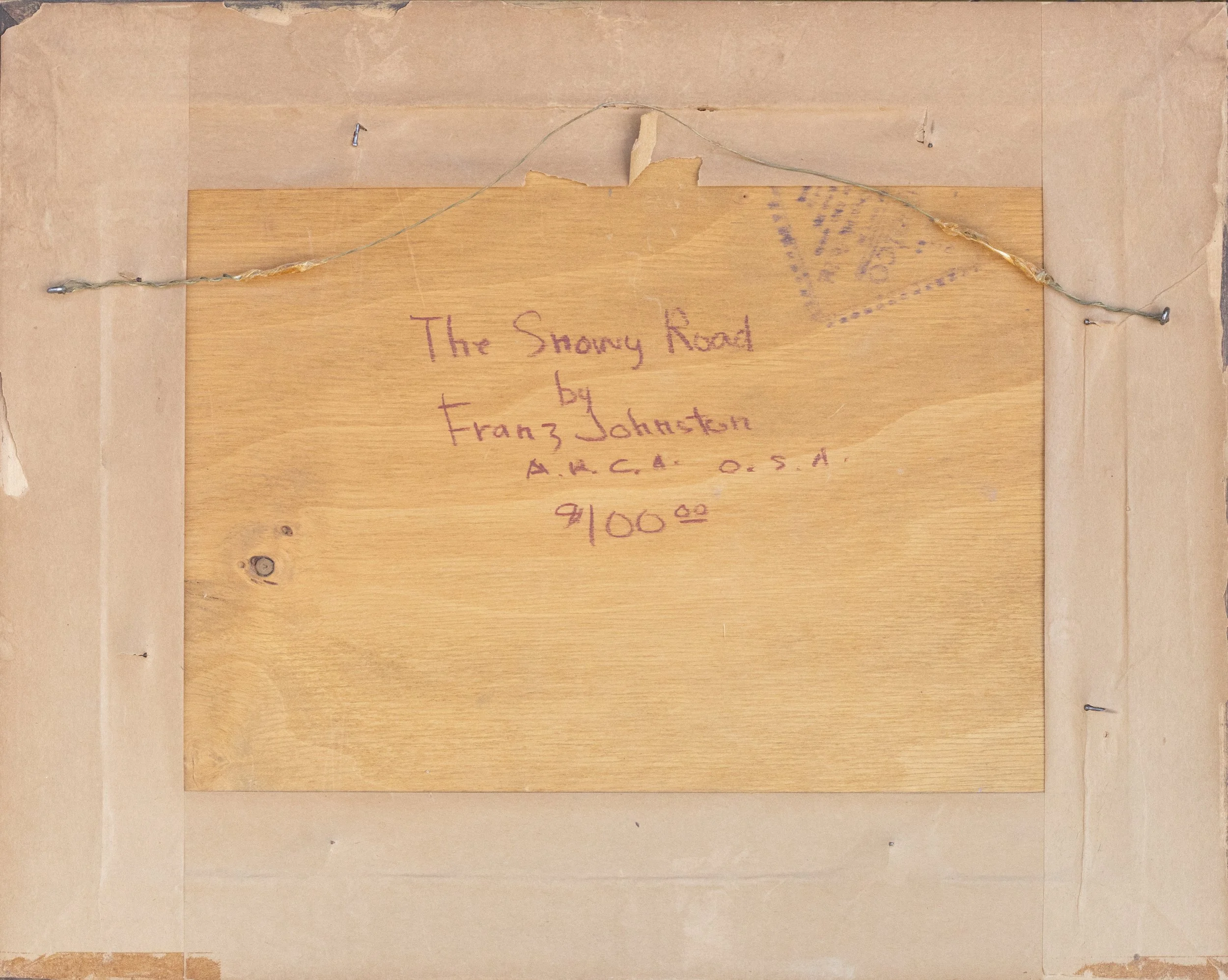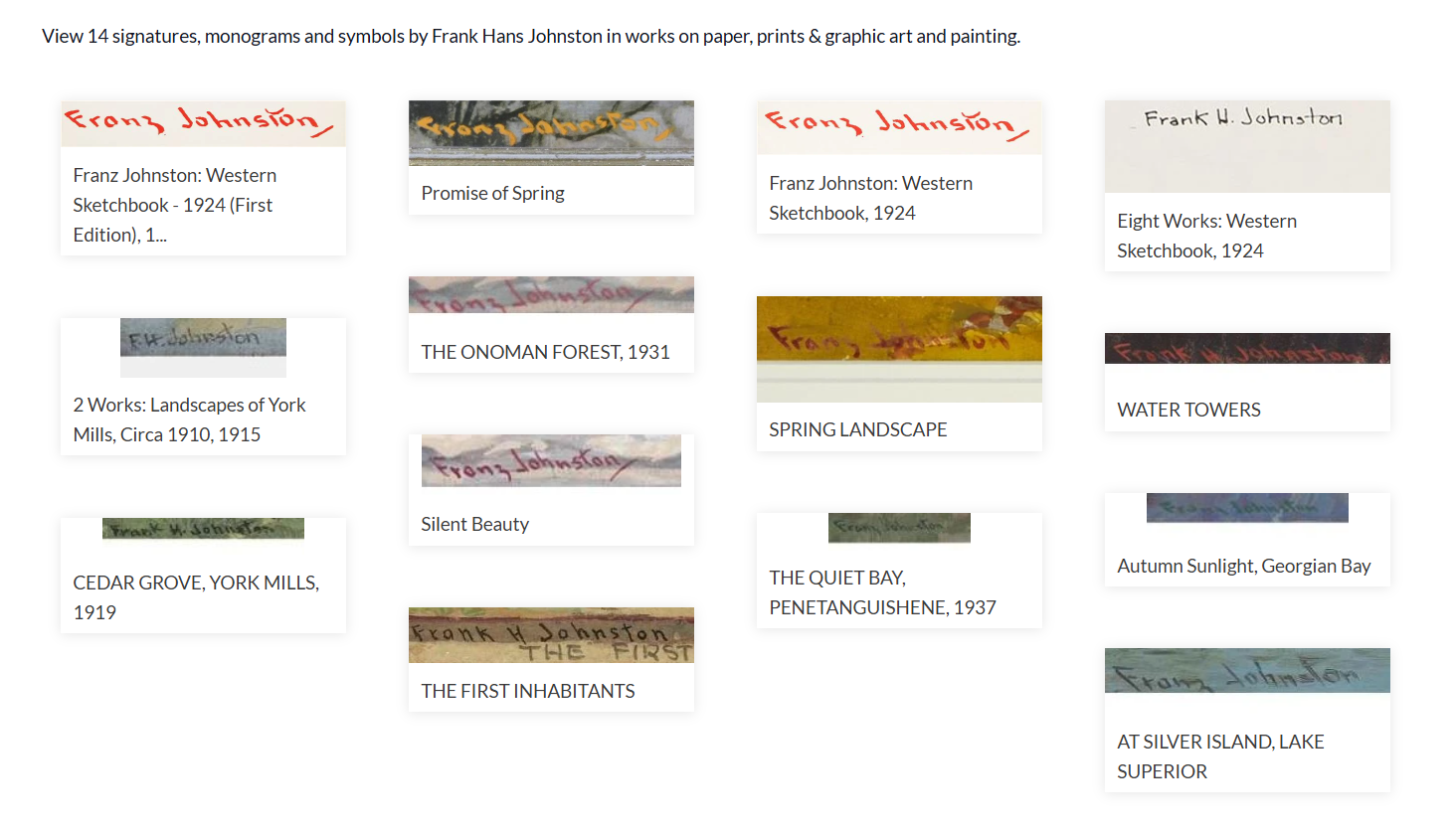Frank Hans (Franz) Johnston
(1888 - 1949) ARCA CSPWC G7 OSA
***SOLD***
Artist: Frank Hans (Franz) Johnston (1888 - 1949) CANADIAN
Title: The Snowy Road
Media: oil on board
Size: 15.5” x 11.5”
Notes: circa 1935, signed lower right,
title, artist name, inscription A.R.C.A O.S.A. verso, framed
Provenance:
Private Collector since 2015, Mississauga, ON
Private Collector, Toronto, ON
(Likely acquired from The Roberts Gallery, Toronto, where the first collector had acquired other works)
Original price $100
This painting, The Snowy Road, evokes Johnston’s mastery of winter light and texture. Painted with oil on board, a winter road, blanketed in snow, crossing a bridge captures both stillness and movement: the soft tracks in the snow, the winter trees just beyond, and a pale sky that suggests cold but clear air. Johnston's signature in the lower margin confirms authorship, and what stands out is his ability to render snow not simply as white, but as a complex field of colour — subtle pinks, purples, blues, and golden light in the shadows and reflections.
For collectors, this kind of painting is appealing for several reasons:
Authentic Winter Subject: Johnston frequently painted snow-scenes, which are among his most popular works, particularly among Canadian collectors.
Decorative Qualities: The composition is simplified but elegant; fences, road tracks, and trees are arranged to guide the eye and give rhythm, making it aesthetically pleasing.
Atmospheric Light: The way Johnston captures indirect light — possibly early morning or late afternoon — adds a sense of mood that elevates mere landscape into something evocative.
Collector’s Note: Today, Johnston’s oils on board—especially those featuring winter landscapes or northern subjects—are highly sought after. While they often trade in the mid-range of Group of Seven prices ($6,000–$15,000 CAD for smaller oils), exceptional or large-scale works can achieve far more. This spectrum of price points makes Johnston one of the more accessible entry points for collectors seeking an original member of the Group of Seven, while still offering the prestige of owning a blue-chip Canadian artist.
Artist Signature Authentication
ABOUT THE ARTIST
Franz Johnston (1888–1949)
Francis Hans Johnston—known first as Frank and later as Franz—was a founding member of the Group of Seven and one of the most prolific Canadian painters of his generation. Born in Toronto in 1888, Johnston received unusually strong academic training compared to his peers. He studied at Toronto’s Central Technical School and Ontario College of Art under Gustav Hahn, William Cruikshank, and G.A. Reid, and later continued his studies in Germany (1904–07) and at the Pennsylvania Academy of Fine Arts in Philadelphia. This formal foundation gave him a distinctive command of drawing, design, and composition, qualities that would set his work apart within the Group of Seven. Unlike some of his peers who struggled for recognition early on, Johnston found immediate success. His solo show that same year at the T. Eaton Company Galleries featured an astounding 200 works, a feat that signaled both his prolific nature and the public’s appetite for his art.
After early commercial work at Grip Ltd. in Toronto—where he met Tom Thomson, J.E.H. MacDonald, and other future Group members—Johnston gained recognition through his war art commissions, capturing the aerial training activities of Canada’s pilots during the First World War. In 1920, he exhibited in the Group of Seven’s landmark first show at the Art Gallery of Toronto. While his colleagues leaned toward modernist boldness and rugged simplification, Johnston’s approach remained more decorative, atmospheric, and precise. His work often revealed an almost Art Nouveau sensibility: lyrical rhythms of trees, stylized skies, and surfaces suffused with light. Where others leaned toward spiritual abstraction or brooding emotional tones, Johnston embraced decorative light, clarity, and harmony. His canvases shimmered with snow’s reflective brilliance, crystalline skies, and the subtle transitions of northern light.
Though he helped launch the Group, Johnston soon diverged. In 1921, he became Principal of the Winnipeg School of Art, and by 1925, he had formally distanced himself, pursuing a solo career and adopting the name “Franz” Johnston—a change influenced by a numerologist’s advice. This independence, far from diminishing his stature, allowed him to thrive commercially and artistically on his own terms.
Snow and Light: Johnston’s Signature Vision
Johnston became especially celebrated for his mastery of snow and light. Few Canadian painters could capture the way snow both reflects and absorbs colour—the subtle violets in shadow, the brilliance of sunlit drifts, the soft tonal gradations of twilight. For Johnston, snow was not only a seasonal motif but a subject of endless atmospheric variation. His winter roads, bridges, and forest clearings pulse with quiet radiance, elevating everyday Canadian scenes into poetic meditations on light.
Compared to Lawren Harris’s spiritual austerity or A.Y. Jackson’s rugged brushwork, Johnston’s paintings felt more intimate, decorative, and deeply attuned to the visual music of nature. This gave his canvases wide appeal among private collectors, who admired both their beauty and accessibility. Johnston captured the more intimate, tactile beauty of northern winters. His paintings glow with an almost jewel-like quality, the kind of decorative elegance that appealed to both critics and the broader public.
The Enduring Glow of a Canadian Legacy
Although Johnston formally separated from the Group of Seven in 1922, his independence brought him considerable success. He went on to direct the Winnipeg School of Art, teach at the Ontario College of Art, and maintain a remarkably productive career painting across Ontario, Québec, and Canada’s North.





